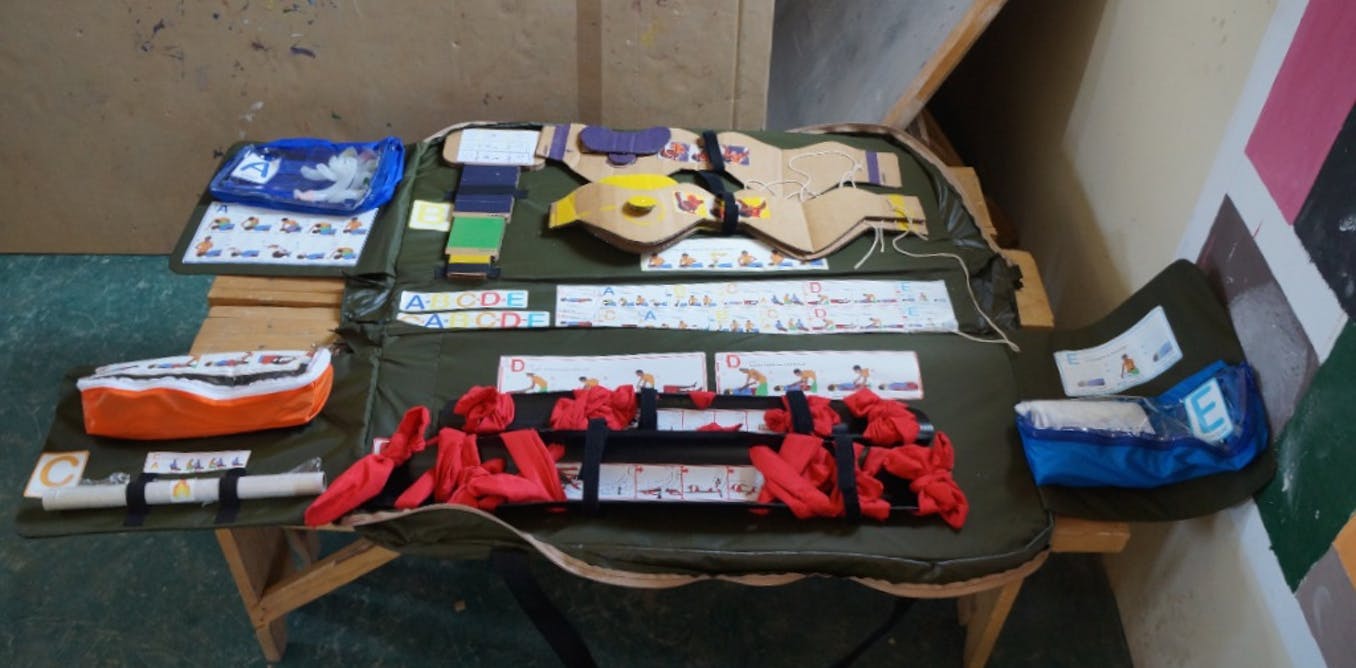We made a lightweight trauma pack to save and change lives on rural African roads

These packs have already been deployed to villages in Zambia Author provided
It’s a common misconception that design is about aesthetics; it’s a great deal more involved than that. Sometimes good design can mean the difference between poverty and prosperity, or even life and death.
For the past few years, we have been investigating how we could help alleviate the effects of road traffic injuries in Zambia. Collaborating with Judith Hall, an anaesthesiologist at Cardiff University, who initiated the project, our aim was to develop lifesaving equipment using a multi-disciplinary approach. We provided the design and ethnographic expertise and Hall gave her medical knowledge on what we needed.
Road traffic injuries (RTIs) are one of the leading causes of death among young people in Zambia. Some 70% of those who die in road accidents are the “breadwinners” in their household, which has resulted in RTIs becoming a major contributor to spiralling poverty in the region. In total, RTIs cost developing countries between 1% and 5% of GDP so although these incidents may feel like personal matters, they have huge social ramifications.

The packs are intuitively designed and require no training to use.
Author provided
Proper treatment in the immediate aftermath of an RTI makes a major difference between whether a victim lives or dies. Should they survive, it decreases the chances of major, lifelong disabilities, the consequences of which have very serious implications for the future of their dependants. Unfortunately, developing nations cannot normally afford medically trained personnel, nor the trauma equipment needed – a standard trauma pack can cost around £600 (around US$750).
It was with this in mind that we began to develop a pack specifically for this context. The resulting kit, which includes a neck brace, splints and bandages, can be used to stabilise RTI victims before they can receive proper medical attention. Each item is designed to prevent non-qualified first responders doing more harm than good. The neck brace, for example, has no access hole for a tracheotomy to be performed.
The pack and each item it contains is made from locally available materials using processes that are viable locally. The neck braces, for example, are formed from hand-waxed and sealed cardboard, while drainpipes are used as the basis for splints, and bicycle inner tubes for pressure bandages. It can be stored for long periods of time in village leaders’ houses along major roads and will not degrade in rainy conditions. As the majority of the RTI first responders in Zambia are illiterate and untrained, the pack is made up of intuitive, life-saving equipment with easy-to-understand instructions that walk users through the globally-standard ABCDE sequence of care.
The trauma pack concept was also conceived as an enterprise development opportunity for manufacture and deployment in Zambia, using cheap, accessible, local materials and low-tech manufacturing processes. And the design – which was developed with the active involvement of 105 people from all walks of life in Zambia, and 25 medical experts in Britain – costs around 95% less than those available in the UK.

A sample neck brace from the pack.
Author provided
We are now looking to run a pilot project in Zambia, and trial the trauma pack along a section of the Great Eastern Road, a major highway. From there we want to build the necessary links and knowledge, and get approval for the construction of a sustainable infrastructure to produce and deploy the packs.
Global help
Though our team’s work will hopefully have a great effect on the treatment of RTI victims in Sub-Saharan Africa, use of the pack is not limited to this situation. We have started looking at how some of the concepts can be used outside the developing world, and have consulted experts in the British National Health Service, Red Cross, Welsh Ambulance Service and the UK’s Ministry of Defence to create a new, patent-pending design to be manufactured in the UK and sold in Europe and beyond. We are in the process of signing a licensing agreement with a manufacturer, and the first of these Zambia pack spin-offs is aimed at meeting the needs of the International Committee of the Red Cross.

The Red Cross pack is specifically designed for single use in times of humanitarian crisis.
The Red Cross Pack is very light, very cheap and compact. Like the Zambia Pack, it is designed to allow people with minimal training to treat the most common traumas. Though it was inspired by the Zambia Pack, the design is entirely different: it is a single-use, single-patient kit for deployment in large-scale humanitarian emergencies such as earthquakes.
Each of these packs is suitable for adults of all sizes and contains a low-cost three-in-one size neck brace (patent pending) and a six-in-one size arm and leg splint kit (patent pending). Both the neck brace and splints are made from corrugated plastic, and the whole kit is contained in a light-weight cardboard box with clear infographic directions.
We also have a series of other project ideas for the developing world. Plans are fluid at the moment, but in the mid-term we would like to set up a not-for-profit organisation co-owned by our two universities to support developments through grants, charitable donations and profit-making activities.

I am a Co-I for an MRC-funded research project connected to this work (to carry out a series of trials in Namibia). I am also the PI of a research project funded by the Life Sciences Bridging Fund that focuses on the development of this pack for production. Lastly I have applied as PI for funding from The Waterloo Foundation which, if successful, will support the development of the pack into sustainable manufacture, distribution and use in Zambia.
Clara Watkins works for Cardiff Metropolitan University owns shares in the Trauma Pack.







